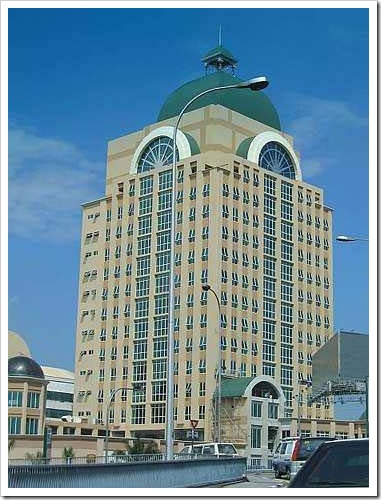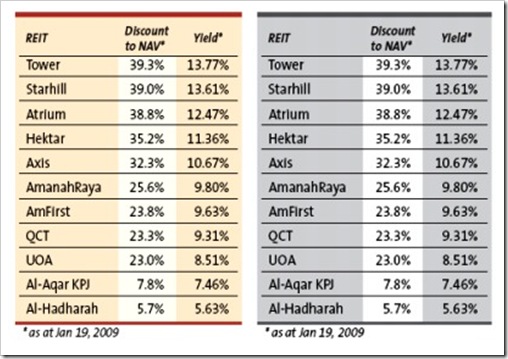Reviewing Malaysian REITs
This is an interesting article on REIT taken from The Star!
Enjoy it! 🙂
Reviewing Malaysian REITs
THE Malaysian real estate investment trusts (MREITs) were launched in 2005 after REITs in general hit the stock markets in Japan, Hong Kong and Singapore. Within a year 10 REITs were launched, one repackaged with another two oldies remaining, making up 11 REITs.
Before the global financial turmoil in 2008, the MREITs performed predictably well, yielding 6% to 7% dividend returns with marginal growth in share premium.
By end-2008, along with the rest of the equities market, the MREITs took a severe beating from which they have hardly recovered.
Some salient points of the MREITs are worth noting.
? REITS share prices have declined substantially.
The MREITs today show a substantial discount to the net asset values (NAV) of the assets underlying the REITs, ranging from 23% to 39% (as shown in Table 1). The property market, in general, has not shown such drastic changes in values over 2007.
Although the asset base of the MREITs has increased, much of this is due to the injection of new and additional assets and not because of increases in asset values or appreciation in values.
The peculiar nature of this phenomenon is because of the nature of the REITs.
? On a down market, REITS show equity tendencies, on an up market, REITS show bond tendencies.
Much research has been carried out by academics as to the behaviour of REITs. The research has been inconclusive.
It will appear, from the little information and research that can be done in Malaysia, that MREITs have a tendency to behave like an equity in a down market, that is, if the stock market declines the MREITs will also follow suit, irregardless of the stability, or otherwise of the underlying asset.
However, in an upswing, the fixed nature of the income and the inability of the underlying asset to react quickly forces the MREITs to behave like a fixed-income instrument, like a bond. This phenomenon would explain why the MREITs are now selling at a discount to the NAV.
? Income to continue at current levels.
It is anticipated that the current income of the MREITs will continue at current levels and may not be affected by the general downturn. Almost all the MREITs were launched before 2007; therefore the rents underpinning their income were at 2006 and 2005 levels.
It is believed that these rents are sustainable and the majority of MREITs did not increase the rental levels to the high levels reached in 2007. Hence, the income and the dividend flow is expected to continue.
? Sale and leasebacks will continue to perform better.
Another reason the income will be sustainable is because a number of MREITs has secured guaranteed returns on a sale-and-leaseback basis. Therefore, the downturn in the market is shielded.
? Yields have increased tremendously.
The sustainable income, coupled with the decline in the net asset value, has boosted dividend yields to between 6% and 14%. Table 1 explains the dividend yield position of the MREITs in January 2009. These returns show, on average, an increase of 50% over the previous yields.
? Singapore yields even higher due to a sharper drop in REITS pricing.
The sharper corrections to the equities market and the more prominent impact of the economy has affected the Singapore REITs, pushing prices down and, thus, increasing yields. Some REITs are giving yields in excess of 25% in Singapore.
? Injection of new assets will face yield disparities.
The yield disparities have affected the injection of new assets into existing REITs. Most real estate pricings and rental incomes fall between 6% and 8% for commercial properties. When current yields are in excess of these returns, REIT sponsors will be unable to inject new assets at below the dividend yields.
? Opportunities for acquisition of better quality asset.
However, the current downturn can also provide wonderful opportunities for the acquisition of better quality assets and a more competitive pricing of the real estate.
? Refinancing.
Financing for REITs has been different from normal financing. As the requirement is for the income to be distributed, almost all the MREITs have been servicing only the interest component of the loan; there is no repayment, partially or otherwise of the loan.
This, coupled with the lower negotiated interest rates regime, has helped the MREITs to declare a higher dividend than the yields from the underlying asset.
In a number of cases, refinancing may be soon. In view of the reduced interest rates currently being considered by the financial institutions, it might be easier to get a lower interest rate.
The MREITs appear to have weathered the financial storm well as the discounts to the net asset value is manageable and not as severe as in other countries.
Added to that is the sustainable income from the rents.
It would appear, therefore, that MREIT yields will be maintained and the downside risks are manageable.
PEPS is the acronym for Persatuan Penilai & Perunding Harta Swasta Malaysia (Association of Valuers and Property Consultants in Private Practice Malaysia). We welcome your feedback on this article. Please email to starbiz@thestar.com.my.
Article Source: The Star


[…] For more about REIT read Reviewing Malaysian REITs […]
Axis Reit Plans New Acquisitions, Raise War Chest
KUALA LUMPUR, Jan 21 (Bernama) — Axis Real Estate Investment Trust (REIT) plans to acquire another three to five properties in 2010 and raise RM113 million in the early part of the year.
Its target was expand the total assets to at least RM1 billion from RM907.7 million as at December last year, said Axis REIT Managers Bhd Chief Executive Officer Stewart LaBrooy.
Axis REIT Managers is the promoter of Axis REIT.
LaBrooy said the potential acquisition targets included two units of brand new logistics warehouses in Johor, a factory or warehouse in Puchong and an office building in Cyberjaya.
The acquisitions will total RM180 million.
As at Dec 31, 2009, Axis REIT had 21 properties in Malaysia.
In a media briefing on Axis REIT’s financial performance for last year and its future growth prospects, he said: “We are positive about our financial results this year despite the soft property market.
“Our strategy is to maintain occupancy rates and make new acquisitions.”
He said the trust also planned another capital raising exercise in early 2010. “There is potential to place out another 61.4 million units and raise a war chest of RM113 million for future acquisitions,” he disclosed.
LaBrooy said that among other developments for this year would be on its corporate property in Petaling Jaya called Quattro West which was formerly known as Nestle House.
“We are undergoing a complete refurbishment of the building to reposition the asset and increase revenue,” he said.
He said Quattro West would be taken up by another listed company that had committed to a 15-year lease of 50 per cent of the space commencing July.
Another property that would provide unitholders with opportunities for capital gain was the proposed acquisition of two logistics warehouses in Seberang Perai, Penang which was expected to be completed by March.
The Seberang Perai warehouse acquisition at RM24.25 million, he said, was at a 9.2 per cent discount to market value and would provide unitholders with a cpaital gain of approximately RM1.78 million.
“The acquisition will increase gearing level from 34.03 per cent to 35.61 per cent,” he added.
LaBrooy said 35 per cent would be the trigger point for gearing level and should it touch above this level, Axis REIT would a undertake private placement to bring it down.
Axis REIT’s unit price, he pointed out, saw an improvement at the end of 2009 as compared to end of 2008. “It closed at RM1.93, a 72 per cent increase from the 2008 closing price,” he added.
fr:bernama.com/bernama/v5/newsindex.php?id=470079
Loan indicators show strong growth rates
Overall loan indicators in the country registered strong annual growth rates across business and household sectors, Bank Negara said in its latest monetary and financial development report.
On a net basis, banking loans and oustanding private debt securities (PDS) expanded at a combined annual rate of 8.6% as at end of last year.
Gross financing in the banking system and the capital market remained high at RM69.2bil in December, although there was a drop compared with RM84.8bil recorded in November.
In the business sector, demand for financing was lower while loan approvals and disbursement remained relatively strong.
Loans were mainly channelled to the manufacturing, retail, restaurant and hotel, as well as primary agricultural sectors for working capital purposes.
As at end-December, business loans oustanding expanded at an annual rate of 2.6%.
In the household sector, demand for financing of passenger cars and personal loans climbed.
Loans disbursement rose in tandem, and led to the annual growth rate of 10% recorded as at end of December.
Net fund raising activity in the capital market stood at RM4.3bil last month, but was lower compared with November due to several large issuances of PDS and Maxis Bhd’s share sale during the month.
Meanwhile, the average fixed deposit interest rate was unchanged in December.
The average base lending rate stood at 5.51% as at Jan 15, while the average lending rate trended lower to 4.83% as at end of December compared with 4.91% in November.
Broad money supply, or M3, grew at an annual pace of 9.1% and up RM16.6bil on a monthly basis. The increase in M3 in December was due to higher credit by banks to the private sector, higher government spending and net inflows from abroad.
The banking system’s capitalisation remained strong with the risk-weighted capital ratio and core capital ratio at 14.7% and 13.1% respectively.
The net non-performing loan ratio improved to 1.8%, while aggregate loan loss coverage ratio was above 90%.
fr:biz.thestar.com.my/news/story.asp?file=/2010/1/29/business/5571795&sec=business
CapitaMalls to raise RM852mil from M’sian unit’s IPO
SINGAPORE: CapitaMalls Asia Ltd, which owns shopping malls in the region, is raising about RM852mil through an initial public offering of its Malaysian unit in the country’s second-biggest IPO this year.
CapitaMalls Malaysia Trust priced units offered to institutions at RM1 apiece, the low end of its projected price range, according to a Singapore exchange filing yesterday.
The price for individual investors was fixed at 98 sen, it said.
“We are heartened by the success of the offering,” CapitaMalls Asia chief executive officer Lim Beng Chee said in the statement.
“Despite the challenging market conditions, it is priced at one of the tightest yields for a Malaysian real estate investment trust (REIT) initial public offering.”
The IPO follows the RM1.5bil raised by Sunway REIT in its initial sale last month and underscores rising investor appetite for equities in Malaysia amid an economic rebound from last year’s recession.
CapitaMalls Malaysia’s IPO may be surpassed by share sales of two units of Petroliam Nasional Bhd.
CapitaMalls Malaysia Trust was scheduled to list on July 16 when JPMorgan Chase & Co would act as stabilising manager, the company said in a separate exchange filing yesterday.
JPMorgan, CIMB Investment Bank Bhd, JPMorgan Chase & Co and Maybank Investment Bank Bhd are jointly managing the sale.
“It is a good proxy to the Malaysian REIT sector that we believe is due for another round of re-rating,” RHB Research Institute analyst Joshua Ng said in a report yesterday. “Its growth prospects are good, underpinned by growing rentals and acquisitions.”
Singapore-based CapitaMalls Asia, part of South-East Asia’s biggest developer CapitaLand Ltd, owns shopping malls in China, India and Singapore.
CapitaMalls Malaysia is the owner of the Sungei Wang Mall in Kuala Lumpur, The Mines mall which is located south of the city centre, and Gurney Plaza in Penang, according to the company’s prospectus
fr:biz.thestar.com.my/news/story.asp?file=/2010/7/9/business/6630486&sec=business